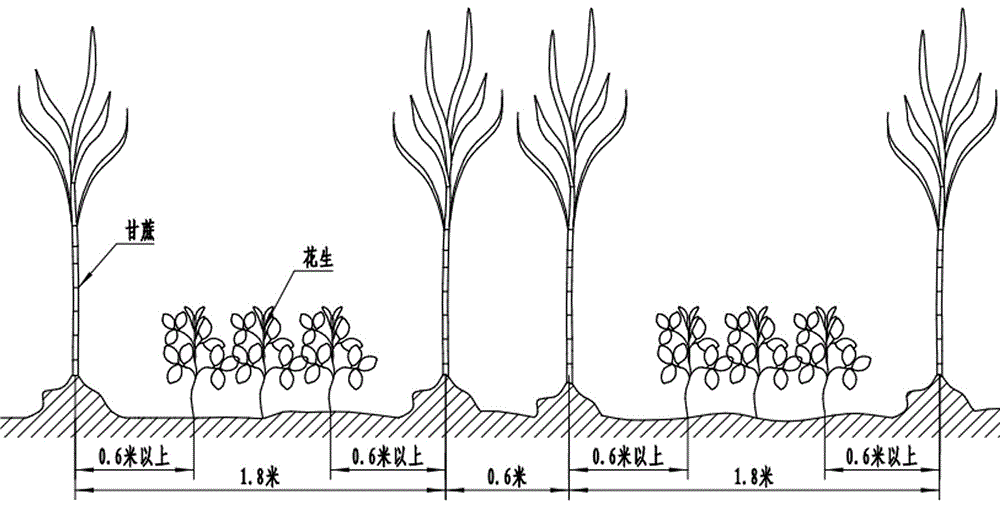Method of interplanting peanut among single-row and single-bud sugarcane stem
A technology of sugarcane stems and wide and narrow rows, which is applied to the field of interplanting peanuts in single-row single-bud sugarcane stems and wide-narrow rows, which can solve the problems of unfavorable mechanized operation and management, large amount of sugarcane seeds, and disordered growth of sugarcane, so as to achieve favorable agricultural operations and balanced growth , the effect of reducing the amount of seeds used
- Summary
- Abstract
- Description
- Claims
- Application Information
AI Technical Summary
Problems solved by technology
Method used
Image
Examples
Embodiment 1
[0037] Adopt the following steps to complete single-row single-bud sugarcane stem planting wide and narrow row interplanting peanuts:
[0038] (1) At the end of February and the beginning of March each year, plow the land according to conventional techniques, and ditch alternately according to the large row spacing and small row spacing. rice; the planting must be completed before the end of March, because the single-bud planting depends on part of the tiller seedlings growing into effective stems to ensure that the effective stems of the seedlings constitute the output, while the traditional planting mainly relies on the main seedlings to constitute the output; if planting is too late , The growth period of tillering seedlings is too short, and the rate of stem formation is low, which will affect the yield.
[0039] (2) Choose sugarcane free from diseases and insect pests, peel off the outer leaves of the sugarcane stalks, so as not to damage the sugarcane buds, cut the sugar...
Embodiment 2
[0053] Adopt the following steps to complete single-row single-bud sugarcane stem planting wide and narrow row interplanting peanuts:
[0054] (1) At the end of February and the beginning of March each year, plow the land according to conventional techniques, and ditch alternately according to the large row spacing and small row spacing. rice; the planting must be completed before the end of March, because the single-bud planting depends on part of the tiller seedlings growing into effective stems to ensure that the effective stems of the seedlings constitute the output, while the traditional planting mainly relies on the main seedlings to constitute the output; if planting is too late , The growth period of tillering seedlings is too short, and the rate of stem formation is low, which will affect the yield.
[0055] (2) Choose sugarcane free from diseases and insect pests, peel off the outer leaves of the sugarcane stalks, so as not to damage the sugarcane buds, cut the sugar...
PUM
 Login to View More
Login to View More Abstract
Description
Claims
Application Information
 Login to View More
Login to View More - R&D
- Intellectual Property
- Life Sciences
- Materials
- Tech Scout
- Unparalleled Data Quality
- Higher Quality Content
- 60% Fewer Hallucinations
Browse by: Latest US Patents, China's latest patents, Technical Efficacy Thesaurus, Application Domain, Technology Topic, Popular Technical Reports.
© 2025 PatSnap. All rights reserved.Legal|Privacy policy|Modern Slavery Act Transparency Statement|Sitemap|About US| Contact US: help@patsnap.com

